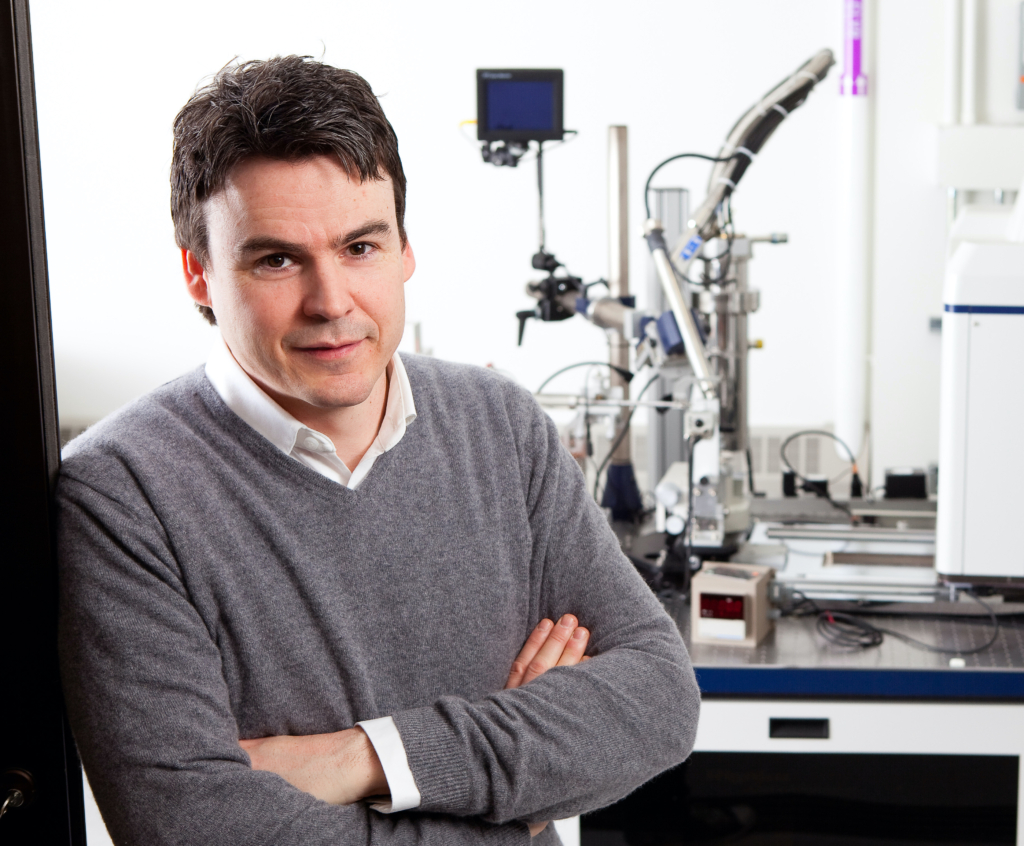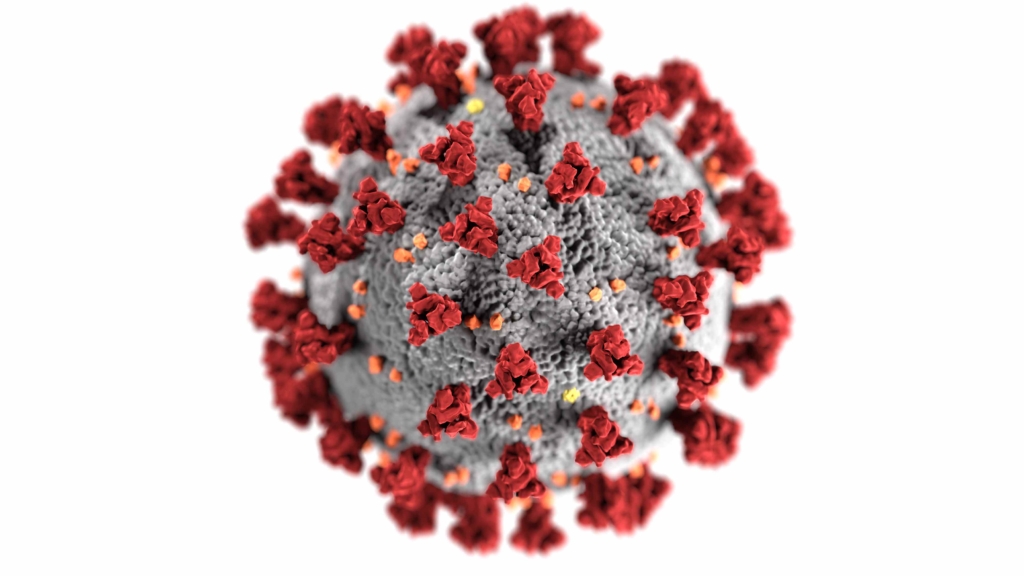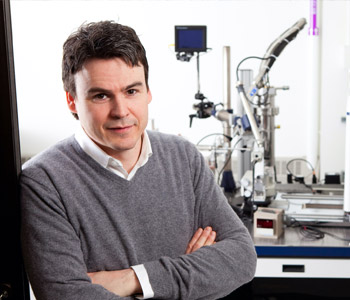Written by: Brian Cole

The coronavirus that causes COVID-19 is nothing if not clever.
Like other viruses, this one is a light traveller, carrying just enough genetic material to replicate and spread throughout the natural world. But it also possesses something that other viruses do not have: the ability to manipulate the immune response of any host it decides to infect.
These two qualities – the ability to travel lightly and disarm immune defences – provide this virus with a huge advantage when it comes to infecting the human body.
Just ask Brian Mark.
A structural biologist at the University of Manitoba, Mark and his eight-member team are currently working with Drs. Marjolein Kikkert and Eric Snijder at Leiden University Medical Center in the Netherlands to develop a vaccine for severe acute respiratory syndrome coronavirus 2 (SARS-CoV-2), which is the virus that causes COVID-19.
The federal government has provided just under $500,000 for the project, which is just one of several COVID-19-related research initiatives underway in Manitoba.
Mark’s interest in coronaviruses – how they work, and how they might be stopped – is not new. In fact, it dates back to 2012 when Mark and his Dutch colleagues started working on a vaccine for the Middle East Respiratory Syndrome coronavirus, also known as MERS. That virus, which emerged in Saudi Arabia, has infected about 2,500 people as of January 2020, and killed more than 800. Mark says the knowledge gained then is being used now to help combat SARS-CoV-2.
As he explains, the pathogen responsible for the pandemic engulfing the world today is part of a family of coronaviruses. Some, like the coronaviruses that cause the common cold, are fairly benign. Others, like the ones that cause MERS and COVID-19, are more deadly. As of mid-June, for example, SARS-CoV-2 had infected about 7.5 million people around the world and killed more than 400,000.
But despite their differences, these coronaviruses do operate in much the same way, and understanding how they function can help inform efforts to create a vaccine for SARS-CoV-2.
This is where Mark’s expertise comes into play.
As a structural biologist, his role is to breakdown the virus structure and identify potential weaknesses that can be attacked by drugs or other therapies. Mark and his team carry out this work with the aid of X-ray crystallography, a technique used to produce three dimensional images of the parts that make up a virus. This provides Mark and his colleagues with a molecular-level view of the virus components, which can be extremely helpful in trying to understand how it functions.
“If you know what your car engine looks like and you can see and visualize all the parts, you can figure out how it works,” he says.

Over the years, Mark has gained important insights into coronaviruses and how they replicate.
As he explains, coronavirus cells contain one gene that produces one very large protein. (Human cells, by comparison, contain many genes and proteins that carry out various functions.)
The large coronavirus protein is effectively controlled by two enzymes called proteases. During the early stages of coronavirus replication in a cell, the proteases cut the large protein into several smaller units, which then carry out various functions in service of the virus. As a result, the virus is able to operate without as many genes, which allows it to remain compact.
“What it has achieved is, it has produced multiple proteins all from a single gene as opposed to having multiple genes within its genome,” says Mark. This is good for the virus because a cell with a smaller genome – the genetic material in a cell – can replicate more easily than a larger one.
In addition to playing a key role in virus cell replication, one of the coronavirus proteases also does something else: it attacks host cells in a way that effectively weakens the immune response to the infection.
“Through some sort of evolutionary process,” says Mark, “it actually assists the virus in establishing the infection by interfering with the immune response of the host cell” he says.
The viral protease does this by recognizing small host proteins known as ubiquitin and ISG15, which play key roles in mounting an immune response by the host cell.
“When a cell becomes infected with a virus, there are many cellular proteins that get ubiquitin or ISG15 attached to them,” he says. “And that allows these proteins to help establish the anti-viral response by the cell. The addition of ubiquitin to cellular proteins also activates a whole bunch of different anti-viral genes that allow cells to begin to defend themselves.”
“Through some sort of evolutionary process, it actually assists the virus in establishing the infection by interfering with the immune response of the host cell.”
But the coronavirus protease cuts this process short. Before the host cell can defend itself, the viral protease basically removes ubiquitin and ISG15 from host cell proteins. “… It basically stops the cell from initiating an effective anti-viral response,” says Mark.
The dual purpose of the protease may be one reason the coronavirus that causes COVID-19 is so virulent, he says.
From a biological perspective, the whole process is quite amazing, says Mark.
“It’s evolution. By chance, (the virus) happened to acquire this function which enhanced its (ability to replicate),” he says. “But you have to remember that evolution like this takes place over time scales that we can’t comprehend.”
But, as it turns out, the virus’s big biological advantage may also prove to be its weakness.
Because the protease is so integral to the development of the coronavirus, it is also a perfect target for drug treatments known as “protease inhibitors,” says Mark.
“Protease inhibitors are fantastic anti-viral targets because without their ability to cut viral proteins into smaller bits, the virus can’t finish its replication cycle,” he says. “It won’t survive.’
Which brings us back to Mark’s work on MERS.
“What we noticed in the crystal structures (while working on a MERS-related virus) is that we could create mutations in the protease so that it could no longer bind to the ubiquitin, so it would no longer be able to remove ubiquitin from cellular proteins to shut down the innate immune response,” Marks says. “… We basically engineered the protease to remove one if its two key functions… and then a recombinant (recombined or re-constructed) form of the virus containing these mutations was created by our colleagues in Leiden.”
Mark and his colleagues were the first to show that the virus protease could be re-engineered to allow for the host cell to keep its immune response system functioning. This approach is now the premise for a potential attenuated viral vaccine for the coronavirus that causes COVID-19, says Mark. (An attenuated vaccine is essentially a live version of the virus that is weak enough to be wiped out by the body’s immune system.)
“You could potentially use that for a vaccine strategy because… (the virus) can still undergo a significant amount of its replication cycle, which allows for a very robust immune response to be generated against it,” he says. “We are now applying those same mutation strategies to the SARS-CoV-2 coronavirus, so we can try to weaken it as well, and then see if that can form the basis for an attenuated virus vaccine.”
Indeed, his colleagues at Leiden are starting to create such mutations in the SARS-CoV-2 virus genome as this story is being written.
“Protease inhibitors are fantastic anti-viral targets because without their ability to cut viral proteins into smaller bits, the virus can’t finish its replication cycle. It won’t survive.”
But Mark’s work on SARS-CoV-2 does not end there. He is also teaming up with Dr. Sachdev Sidhu, an expert in structure-based and combinatorial protein engineering at the University of Toronto, to tackle the coronavirus from a different angle.
As Mark explains, the ubiquitin protein contains a number of different amino acids. Change a couple of the amino acids, and you change the function of ubiquitin.
Sidhu came up with an idea of creating a library of ubiquitin mutants. He thought if you mutate this thing, you could find variants of ubiquitin that could bind to a protease very tightly.
Turns out, he was right.
Mark and Sidhu have shown that it is possible to create mutants of ubiquitin capable of binding to an enzyme of the SARS-CoV-2 protease (called PLpro) that is needed for replication. “And that strategy could be used to block the protease from functioning, as we have shown for MERS coronavirus. And so when you take those variants of ubiquitin and express them in a host cell, those cells are basically immune to coronavirus infection.”
Only one problem.
“You can’t really use a protein like that as a drug because it’s hard to get a protein into a cell where it needs to be,” he says.
Instead, Mark and Sidhu are currently in the process of identifying small chemical molecules that can serve as a substitute for the mutant ubiquitin. “If (a small molecule chemical) displaces the ubiquitin variant, then it too is a tight binder that could block PLpro function,” says Mark.
Small molecule chemicals are stored in vast libraries and commonly used in the development of new drugs. Mark says they have advantages over the larger ubiquitin variant because they have the potential to be developed into therapeutics with good bio-availability, meaning they can be readily absorbed by the body.
So how long before Mark and his colleagues come up with a vaccine?
“That’s a tough question,” he says, noting that vaccine development usually takes decades.
“Two months ago, I was skeptical about any kind of vaccine being developed any time soon. But now, with all the response and effort from the scientific community – which has been quite astounding – I am much more hopeful that something will make it across the finish line sooner than later.”
Brian Cole is a Winnipeg writer.

